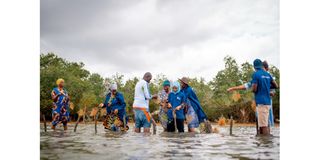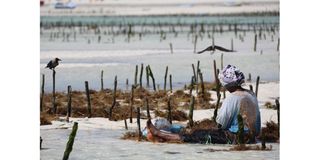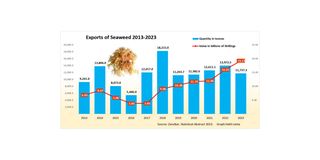Seaweed Farming: Prosperity or peril in the face of climate change?

Seaweed farmers from the Bagamoyo Seaweed Farming Initiative plant seaweed along the shores of Bagamoyo, as photographed recently. PHOTO | THE CITIZEN CORRESPONDENT
What you need to know:
- This is the Bagamoyo Seaweed Farming Initiative, a project located near the Bagamoyo fish market in Bagamoyo Municipal, Coast Region, about 10 kilometers from Bagamoyo town.
Zanzibar/Coast. Near the shores of Bagamoyo, where the Indian Ocean’s waves meet the coastline, a group of determined women wade through the water, tending to their floating seaweed farms.
This is the Bagamoyo Seaweed Farming Initiative, a project located near the Bagamoyo fish market in Bagamoyo Municipal, Coast Region, about 10 kilometers from Bagamoyo town.
At the heart of this initiative is Ms Zuhura Shaweji, a dedicated advocate for sustainable livelihoods.
This project revitalises marine ecosystems and empowers coastal women and girls economically.
“We empower coastal women and girls through sustainable seaweed cultivation, combining marine ecosystem restoration with economic empowerment,” explains Ms Shaweji.
“Women in coastal areas rely on natural resources but are often excluded from economic opportunities. Seaweed farming is a nature-based solution that can change that,” she added.
She said the initiative has established two young-woman-led farming groups with 30 members, trained participants in sustainable farming techniques, and begun harvesting. The focus is now on adding value and expanding markets.

A woman plants seaweed on the shores of a village in Jambiani, Zanzibar. The seaweed is bought by Seaweed Zanzibar Co. Ltd. PHOTO | THE CITIZEN CORRESPONDENT
“We had no formal employment, but this initiative has given us hope. Now, we can support our families by producing and selling various seaweed-based products,” said one of the beneficiaries, Ms Agnes Makorere.
The initiative has 36 direct beneficiaries, including 31 women and girls and 5 men, who support farming and transportation.
Indirectly, over 100 community members benefit from knowledge-sharing and economic opportunities.
“Women now earn between Sh120,000 and Sh500,000 per harvest cycle of 40 kilogrammes, and the potential is even huge with value-added products,” says Ms Makorere.
Ms Shaweji said over 123 individuals have been trained in cultivation, harvesting, drying, and record-keeping.
Seaweed farming beyond Bagamoyo
Bagamoyo’s initiative is just one among many as seaweed farming supports numerous coastal communities in Tanzania, especially in Zanzibar, Mtwara, Coast, and Tanga.
According to the Zanzibar Seaweed Cluster Initiative (ZaSCI), more than 30,000 people are employed in the sector, with women comprising 80-90 percent of the workforce.
However, climate change is destabilising the industry and affecting livelihoods, particularly for women.
Rising sea temperatures, ocean acidification, and erratic weather patterns are reducing seaweed yields, threatening the economic stability of communities.

Ms Zuhura Ahmad Shaweji stands with a group of women from the Bagamoyo Seaweed Farming Initiative, showcase products made from seaweed. PHOTO | THE CITIZEN CORRESPONDENT
Challenges in seaweed farming
Data from the Zanzibar Statistical Abstract 2023 indicates that seaweed production dropped by 16 percent to 11,737 tonnes in 2023 compared to the previous year.
Although current-year data is yet to be released, farmers report that production has dramatically declined following Cyclone Hidaya in May.
In areas such as Tanga's Pangani district, seaweed farming groups have reported losses.
The seaweed farmers' secretary in the area, Mr Hamza Hamis, said before the cyclone, they were harvesting up to 30 tonnes per month, but now, they produce only 900 kilogrammes to one tonne.
“The cyclone destroyed a lot of our seaweed farms. Since we plant near the shore, storms bring debris and mud that damage the seaweed, reducing its value,” explains Mr Hamis.
He also notes that group membership has dropped by 74 percent, from an average of 250 people (76 percent female) to just 65 (80 percent female).
Mwani Zanzibar Co. Ltd Manager, Mr Pius James said frequent cyclones and rising sea temperatures are slowing seaweed growth, reducing yields, particularly for shallow-water farmers.
ZaSCI reports that Zanzibar’s seawater temperature has increased from an average of 31°C to 38°C, whereas seaweed thrives at around 31°C.
“Green aquatic plants growing in the sea pose another challenge. They hinder seaweed growth, requiring constant clearing,” adds Mr James.
Seaweed farmer at Kiunga in Zanzibar, Ms Saada Hamisi said: “When we plant, the seaweed doesn’t grow well due to heat. We’ve tried sourcing better seedlings from Uroa and Pongwe, but they rot before maturity.”
This forces farmers to cultivate in deep waters, which presents another challenge.
The Jambiani seaweed farmer, Ms Pili Halili Pandu, says: “We don’t know how to swim, and we lack the modern equipment to take us to and fro the deep sea waters.”
Ms Pandu, one of the 10 women employed at Mwani Zanzibar Co. Ltd, also points out low wages as another issue: “Depending on our workload, we earn between Sh50,000 and Sh250,000 per month.”
Another farmer, Ms Mwanamkuu Makumbuli, explains that due to low earnings, she maintains a small private seaweed farm in a nearby village to supplement her income.
Responding, Ms Shaweji acknowledges the outlined challenges: “Seaweed farming faces hurdles like poor market access, climate change, and low investment.”
ZaSCI researcher Dr Flower Msuya, notes an additional environmental issue as farmers use mangrove pegs to support seaweed farms, contributing to mangrove deforestation and prompting the government to ban this practice by introducing strict regulations.
She also highlights the post-harvest losses during rainy seasons and the prevalence of diseases like ice-ice and epiphytes, which affect seaweed quality.
“Moreover, limited research on alternative high-value seaweed species such as gracilaria, sargassum, and ulva spp. restricts diversification opportunities,” she says.

Growth opportunities
Seaweed farming significantly contributes to Tanzania's economy, particularly in Zanzibar.
In 2022, Zanzibar's total export value reached $185.5 million (Sh482.3 billion), with seaweed exports playing a vital role alongside cloves and manufactured goods.
The Ministry of Blue Economy & Fisheries Permanent Secretary in Zanzibar, Mr Hamad Bakar Hamad, says they are expanding the blue economy sector by improving laws, providing training, and distributing boats to farmers and fishermen.
However, Dr Msuya says ZaSCI has grown from 21 members in 2006 to over 60 groups with 700 processors, increasing employment opportunities.
“Value addition can boost prices from an average of $0.6 (Sh1,560) to $20 (Sh52,000) per kilo,” she explains.
Research suggests farming seaweed in deep-sea waters (2-6 meters at low tide) yields better results.
Furthermore, Ms Shaweji’s leadership has gained global recognition as a Restoration Steward under the Global Landscapes Forum (GLF) and Youth in Landscapes Initiative (YIL), therefore receiving international support.
“Through this initiative, we receive education and funding to further marine conservation and empower more women,” she says.
Looking ahead, the initiative plans to expand to five more coastal villages by 2026, establish a community processing centre, launch a youth seaweed incubator, and form partnerships for export and climate adaptation.
While most seaweed is sold to local collectors and exporters, efforts are underway to develop direct market linkages with pharmacies, hospitals, and cosmetic manufacturers.
Seaweed environmental role
Environmentally, seaweed absorbs excess nutrients, impounds carbon, and provides habitats for marine life.
“It’s about restoring the marine ecosystem and empowering women to lead conservation efforts,” says Ms Shaweji.
According to Nature Communications (2019), seaweed absorbs carbon dioxide, helping mitigate climate change by storing carbon in deep-sea sediments.
Studies in Frontiers in Marine Science (2020) reveal that seaweed reduces wave energy by up to 30 percent, protecting coastlines from erosion and storm surges.
However, reports from the Food and Agriculture Organization (FAO, 2018) highlight that seaweed farming requires no freshwater, fertilisers, or arable land while absorbing excess ocean nutrients.
Findings in Marine Science Journals (2001) confirm that seaweed improves water quality by filtering pollutants and preventing harmful algal blooms.
Seaweed is, therefore, crucial for climate regulation, biodiversity conservation, water purification, and coastal protection, making it an essential environmental and economic resource.



